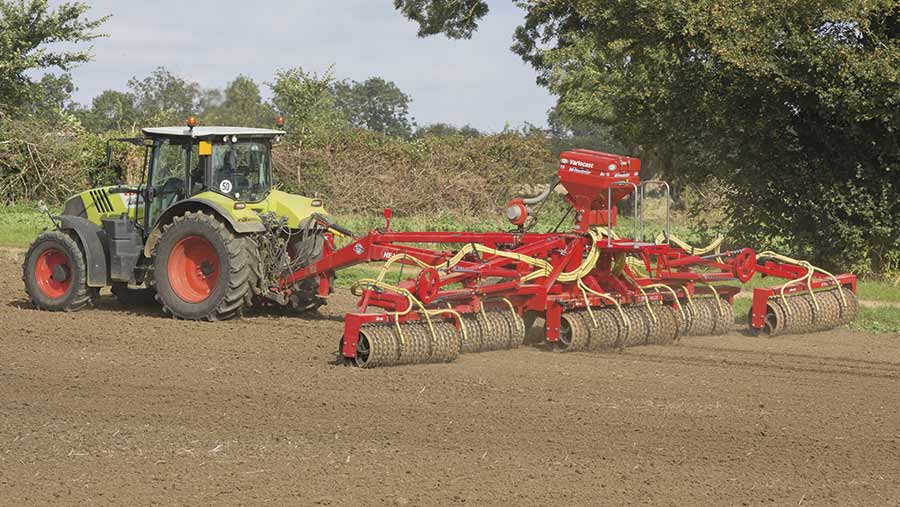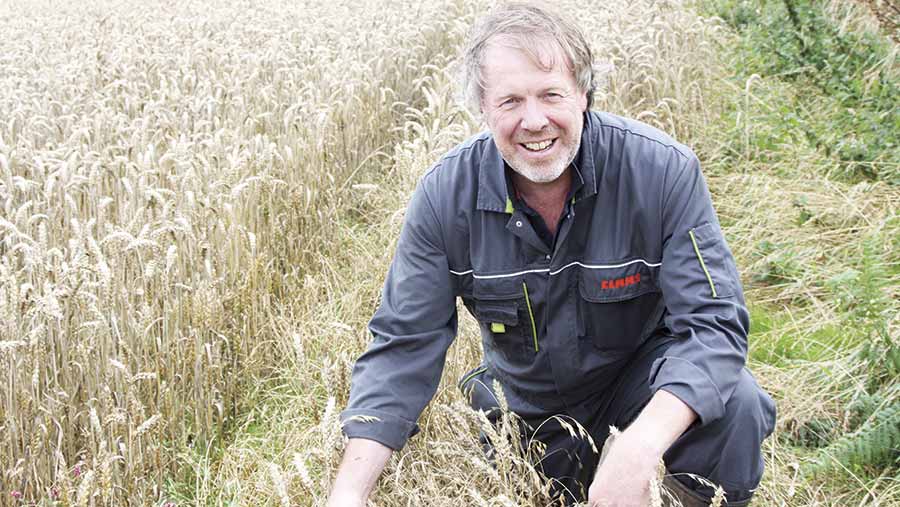Cornish grower devises two-pronged plan to beat brome
 © Tim Scrivener
© Tim Scrivener Bromes have become the biggest threat to profitable cropping for one south-western grower, who is rejigging his establishment strategy to battle the yield damaging weed.
Mike Hambly grows 200ha of winter cereals and oilseed rape alongside his duties as NFU combinable crops chairman.
He is considering cutting back his use of the plough in a bid to keep weed seeds buried, as well as beefing up his chemical control.
Sterile brome has been an issue that has been managed for a number of years by hand-roguing at Westcott Farm, situated in the Tamar Valley in south-east Cornwall, but meadow brome has also reared its head in the past two seasons.
See also: How to identify different brome species

Mike Hambly
The thick and competitive grassweed is appearing in ever more frequent patches on headlands and is causing issues with lodging, says Mr Hambly, reducing yields by up to 50% in areas where it is thick. And it needs to be dealt with before it spreads further into the field.
Invasion from the hedge is the likely starting point of most people’s problems. The problem is more acute in this area as field sizes are smaller, with the average area on Mr Hambly’s farm around 4ha.
Having historically ploughed everything annually, he introduced a Simba Solo two years ago to cut establishment costs and is now looking at the benefits of reduced tillage from a weed control perspective as well.
Currently ploughing ahead of oats and barley in his rotation of oilseed rape, winter wheat, winter oats and winter barley, an increasing issue with weeds is prompting a further rethink.
Establishment trial underway
This season he is conducting a trial to look at the impact of dropping the plough to once in his four-year rotation, between wheat and oats, by establishing half of his barley after ploughing, and half after the Solo.
Ploughing has to be done before oats in order to control wheat volunteers in his premium-grade crop of Mascani oats.
Limiting ploughing to once in the four-year rotation would keep weed seeds buried below germination depth for long enough to kill them off, providing less invasive cultivations can get crops established in the other three years.
With few compaction issues on his land in spite of an annual rainfall of over 1,500mm, he hopes that improving the cultural controls, alongside an increased chemical spend, will battle the blot on his otherwise largely clean cropping area.
New actives introduced
As the south west has been less troubled by blackgrass than the arable heartlands of the east, Mr Hambly has for many years been able to keep his herbicide spend to a minimum, but last year introduced Broadway Star (florasulam + pyroxsulam).
This was applied onto the wheat in March, and left as late as possible as brome is late to germinate, but turned out to be a great success, says Mr Hambly.
However, when he looked around for a contractor to apply Avadex (tri-allate) to his ground ahead of winter barley, he was unable to find anyone with the machine as there are so few people in the region who use it.
He has, therefore, taken the plunge and now has an applicator of his own attached to a new set of rolls that he bought this season.
Managing seed weed populations
Managing the weed seed population is a critical part of reducing brome populations, and steps can be taken to do this throughout the season.
Here are nine top tips from Adas weed expert Sarah Cook and independent soil expert Philip Wright:
- Keep spray drift into hedgerows to a minimum in order to limit the creation of bare patches, which brome species can occupy
- Similarly, keep fertiliser from straying into hedgerows to allow non-threatening species to flourish and stop weeds from gaining a competitive advantage
- Consider adding extra field margin strips to act as a buffer zone between hedgerows and crops – but they will need spraying off or mowing each year. Might not be economical or practical in smaller fields.
- Don’t plough more than once every three years to allow buried seeds to die
- Make sure to go shallower than the plough with subsequent cultivations, unless there are compaction issues
- Move as little soil as possible by making use of low disturbance legs and reduce pressure on soil by lengthening the top link to make the weight sit slightly more on the rear of the machine than the front
- Dig soil pits to assess both the headland and the middle of the field. Often the centre of the field may need less remedial work than the headlands, which have had machinery turning on them.
- If the plough starts sticking don’t be tempted to go shallower as it will not bury properly
- Keep tyre pressures as low as possible on the tractor carrying or pulling the drill to reduce rutting, which will re-expose any seed that has been covered over
All of the speakers were at an event organised by BASF to promote the launch of its Arable Weed Control trials.
There is still time to enter the arable weed survey to claim a £5 Screwfix voucher and be in with the chance of winning a knapsack sprayer.
Farmers Weekly retained full editorial control of this article.

